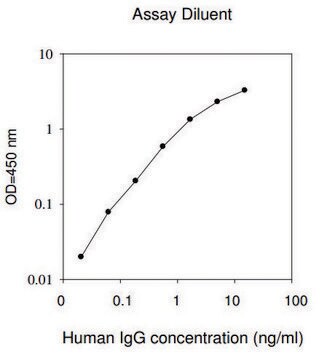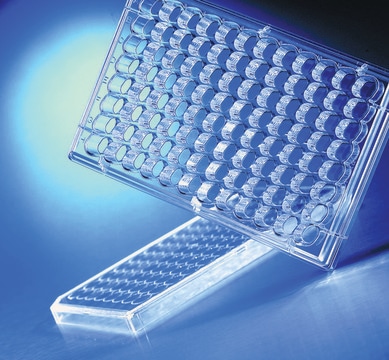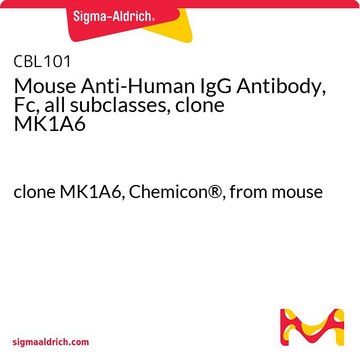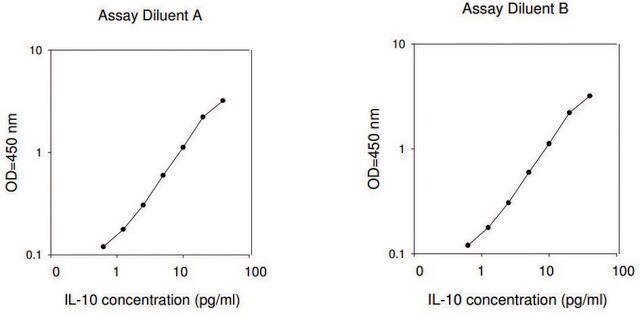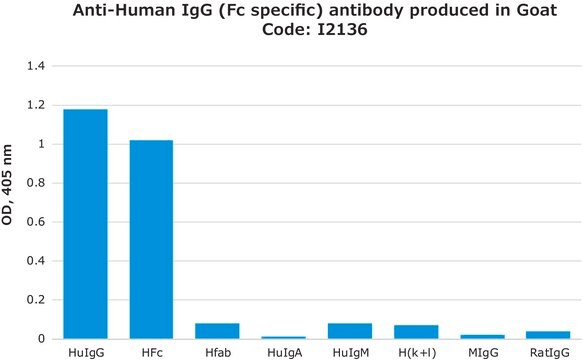Wszystkie zdjęcia(2)
Kluczowe dokumenty
RAB0242
Human IgG1 ELISA Kit
for serum, plasma, conditioned medium, urine
Synonim(y):
IgG1, Immunoglobulina G1
Zaloguj sięWyświetlanie cen organizacyjnych i kontraktowych
About This Item
Kod UNSPSC:
41116158
NACRES:
NA.32
Polecane produkty
reaktywność gatunkowa
human
opakowanie
kit of 96 wells (12 strips x 8 wells)
metody
ELISA: suitable
capture ELISA: suitable
moc wejściowa
sample type plasma
sample type serum
sample type conditioned medium
sample type urine
assay range
inter-assay cv: <12%
intra-assay cv: <10%
sensitivity: 50 pg/mL
standard curve range: 0.05-40 ng/mL
metoda wykrywania
colorimetric
Warunki transportu
wet ice
temp. przechowywania
−20°C
informacje o genach
human ... IGHG1(3500)
Opis ogólny
Zestaw ludzkiej IgG1 ELISA (Enzyme-Linked Immunosorbent Assay) jest testem immunoenzymatycznym in vitro do ilościowego pomiaru ludzkiej IgG1 w surowicy i osoczu.
Immunogen
Rekombinowany ludzki IGG1
Zastosowanie
For research use only. Not for use in diagnostic procedures.
Please refer to the attached General ELISA KIT Procedure (sandwich, competitive & Indirect ELISA)
Please refer to the attached General ELISA KIT Procedure (sandwich, competitive & Indirect ELISA)
Działania biochem./fizjol.
Immunoglobulina ciężka stała gamma 1 (IGHG1) lub IgG1, wyrażana w komórkach raka trzustki, może być zaangażowana w proliferację komórek nowotworowych i mechanizmy unikania odporności. siRNA ukierunkowane wyciszanie IGHG1 opóźnia wzrost komórek i indukuje apoptozę w ludzkich komórkach raka prostaty.
Inne uwagi
Dla tego produktu dostępny jest przykładowy certyfikat analizy.
Wpisz słowo sample w polu tekstowym przeznaczonym na numer partii.
Wpisz słowo sample w polu tekstowym przeznaczonym na numer partii.
Ta strona może zawierać tekst przetłumaczony maszynowo.
Elementy zestawu są też dostępne oddzielnie
Numer produktu
Opis
Karta charakterystyki
Hasło ostrzegawcze
Warning
Zwroty wskazujące rodzaj zagrożenia
Zwroty wskazujące środki ostrożności
Klasyfikacja zagrożeń
Met. Corr. 1
Kod klasy składowania
8A - Combustible corrosive hazardous materials
Wybierz jedną z najnowszych wersji:
Masz już ten produkt?
Dokumenty związane z niedawno zakupionymi produktami zostały zamieszczone w Bibliotece dokumentów.
Klienci oglądali również te produkty
Roxanne Collin et al.
Journal of immunology (Baltimore, Md. : 1950), 193(7), 3503-3512 (2014-08-29)
Autoimmune diseases result from a break in immune tolerance. Various mechanisms of peripheral tolerance can protect against autoimmunity, including immunoregulatory CD4(-)CD8(-) double-negative (DN) T cells. Indeed, we have previously shown that diabetes-prone mouse strains exhibit a low proportion of DN
Xiaoyan Li et al.
Pancreas, 40(5), 753-761 (2011-06-10)
To investigate the expression of Igγ-1 chain C region (IGHG1) in human pancreatic carcinomas and determine the biological function of IGHG1 expression in immune evasion mechanisms. Comparative proteomic analysis was used to detect the differential expression of IGHG1 in human
Bin Pan et al.
Molecular biology reports, 40(1), 27-33 (2012-11-03)
To investigate the immunoglobulin G (IgG) expression in prostate cancer cell lines and explore the effects of IGHG1 gene knockdown on PC3 cell growth and apoptosis. Flow cytometry, qPCR and western blot were used to demonstrate IgG expression in prostate
Arjan van der Flier et al.
PloS one, 10(4), e0124930-e0124930 (2015-04-24)
We recently developed a longer lasting recombinant factor VIII-Fc fusion protein, rFVIIIFc, to extend the half-life of replacement FVIII for the treatment of people with hemophilia A. In order to elucidate the biological mechanism for the elongated half-life of rFVIIIFc
Chanjuan Shen et al.
Vaccine, 32(41), 5337-5342 (2014-08-06)
A better understanding of immune responses in human infants could lead to more effective immunization and vaccination strategies in early life. Since antibodies are key components of protective vaccine responses, we examined developmental changes in serum levels of immunoglobulins (IgG
Nasz zespół naukowców ma doświadczenie we wszystkich obszarach badań, w tym w naukach przyrodniczych, materiałoznawstwie, syntezie chemicznej, chromatografii, analityce i wielu innych dziedzinach.
Skontaktuj się z zespołem ds. pomocy technicznej